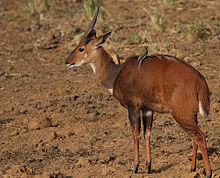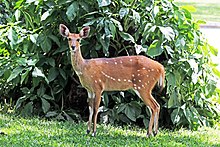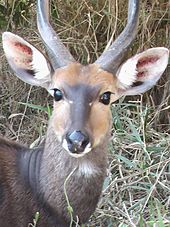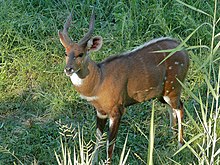Cape bushbuck
This article's factual accuracy is disputed. (October 2017) |
| Cape bushbuck | |
|---|---|

| |
| Male, Kenya | |

| |
| Female, Zimbabwe | |
Conservation status
| |
| Scientific classification | |
| Kingdom: | Animalia |
| Phylum: | Chordata |
| Class: | Mammalia |
| Order: | Artiodactyla |
| Family: | Bovidae |
| Subfamily: | Bovinae |
| Genus: | Tragelaphus |
| Species: | T. scriptus
|
| Binomial name | |
| Tragelaphus scriptus (Pallas, 1766)
| |
The bushbuck (Tragelaphus scriptus) is a common and a widespread species of antelope in Sub-Saharan Africa.[2][3] Bushbuck are found in a wide range of habitats, such as rain forests, montane forests, forest-savanna mosaic, savanna, bushveld and woodland.[3] Bushbuck stand about 90 centimetres (35 in) at the shoulder and weigh from 45 to 80 kilograms (99 to 176 lb). They are generally solitary, territorial browsers.
Taxonomy[]
Bushbuck have been fractured into over 40 subspecies in the past. mtDNA profiles of a large amount of samples were resolved in 2009 as belonging to nineteen groups, some corresponding to previously described subspecies, others were previously unrecognised and remained unnamed. The nineteen groups were then organised into two taxa: a nominate northern subspecies (Tragelaphus scriptus scriptus) and a southern subspecies T. scriptus sylvaticus. In the 1780 original description of sylvaticus from the Cape Region by Sparrman, there is no mention made of striping. According to Moodley et al., males of type populations in West Africa are more often striped than southern and eastern specimens,[3] although this is not always the case.
In 2011, on the other hand, Groves and Grubb advocated recognising the bushbuck population as eight species: Tragelaphus scriptus (Pallas, 1766); T. phaleratus (Hamilton Smith, 1827); T. bor Heuglin, 1877; T. decula (Rüppell, 1835); T. meneliki Neumann, 1902; T. fasciatus Pocock, 1900; T. ornatus Pocock, 1900; and T. sylvaticus (Sparrman, 1780), grouped in a northern and southern 'group'. The Ethiopian decula was classified as a scriptus group species as opposed to Woodley. In the case of Tragelaphus, these 'species' would be based mostly on geography as opposed to genetics.[4] These proposals are controversial.[5]
Description[]


Bushbuck stand about 90 centimetres (35 in) at the shoulder and weigh from 45 to 80 kilograms (99 to 176 lb) (depending on sex). They have a light brown coat, with up to seven white stripes and white splotches on the sides. The white patches are usually geometrically shaped and on the most mobile parts of their body such as the ears, chin, tail, legs and neck. The muzzle is also white and horns are found only on the males and they can reach over half a metre with only one twist. At 10 months old, young males sprout horns that are particularly twisted and at maturity form the first loop of a spiral.[6]
Cape bushbuck[]
In some cases the Cape bushbuck has less striping and is thus more uniformly coloured than populations in West Africa.[3] Cape bushbuck occur from the Cape in South Africa to Angola and Zambia and up the eastern part of Africa to Ethiopia and Somalia, according to one interpretation.[7] Another interpretation restricts the taxon to Southern Africa sensu stricto, or considers them sensu lato to occur in the above range, except eastern Sudan, Ethiopia and Somalia.[4] The first Latin name that can be attributed to the Cape bushbuck was Antilope sylvatica after Sparrman (1780), described from the Cape Colony.[citation needed]


Ecology[]
Bushbuck mainly browse, eating all plant matter that they can reach. Bushbuck are active throughout the day, but tend to be nocturnal near human habitations. They tend to be solitary, though some live in pairs.[6]
Bushbuck live within a "home" area, which is usually around 50 000 square metres on the savannah and much larger in the forest, that they will not normally leave. These areas usually overlap other bushbuck home areas. Bushbuck are basically solitary animals and the mature males go out of their way to stay away from each other.[6]
Some game farmers in southern Africa discovered that the bushbuck may be excluded by the closely related, larger, nyala when they tried to introduce the two species to the same area. However, the two species are found in close proximity in natural communities (e.g., in Gorongosa National Park, Mozambique).[citation needed]
References[]
- ^ IUCN SSC Antelope Specialist Group (2008). "Tragelaphus scriptus". IUCN Red List of Threatened Species. 2008. Retrieved 29 March 2009. Database entry includes a brief justification of why this species is of least concern.
- ^ Wronski T, Moodley Y. (2009). Bushbuck, harnessed antelope or both? Archived 2011-07-08 at the Wayback Machine Gnusletter, 28(1):18-19.
- ^ Jump up to: a b c d Moodley, Y.; et al. (September 2009). "Analysis of mitochondrial DNA data reveals non-monophyly in the bushbuck (Tragelaphus scriptus) complex". Mammalian Biology. 74 (5): 418–422. doi:10.1016/j.mambio.2008.05.003. Retrieved 7 April 2021.
- ^ Jump up to: a b Groves, C.; Grubb, P. (2011). Ungulate Taxonomy. The Johns Hopkins University Press.
- ^ Heller, R.; Frandsen, P.; Lorenzen, E. D.; Siegismund, H. R. (2013). "Are there really twice as many bovid species as we thought?". Systematic Biology. 62 (3): 490–493. doi:10.1093/sysbio/syt004. PMID 23362112.
- ^ Jump up to: a b c "Bushbuck". African Wildlife Foundation. Retrieved June 28, 2008.
- ^ Moodley Y, Bruford MW. (2007) Molecular biogeography: Towards an integrated framework for conserving pan-African biodiversity. PLoS ONE. 2:e454.
External links[]
| Wikimedia Commons has media related to Tragelaphus scriptus. |
- . Encyclopædia Britannica (11th ed.). 1911.
- Gilman, D. C.; Peck, H. T.; Colby, F. M., eds. (1905). . New International Encyclopedia (1st ed.). New York: Dodd, Mead.
- IUCN Red List least concern species
- Tragelaphus
- Mammals of Southern Africa
- Mammals described in 1766
- Taxa named by Peter Simon Pallas
